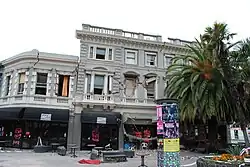William Barnett Armson (1832/3 – 25 February 1883) was an architect, surveyor, engineer in colonial New Zealand. A co-founder of the Canterbury Association of Architects,[1] and an architect to the provincial government,[2] he established the architectural firm of Armson, Collins and Harman in 1870, which remained active until 1993.[3] It was one of the two oldest architectural firms in New Zealand.[4] His most important work was the Bank of New Zealand building in Dunedin.
Early years
Armson was born in London, England. His father, Francis William Armson, was a surveyor, builder, and later an architect. His mother was Jane Barnett.[5] Armson trained in Melbourne.[6]


Career
Armson designed many buildings in New Zealand including banks, churches, houses, offices, schools, and shops.[7] His commercial buildings were based on a Renaissance architectural style. The banks and offices designs were notable for their "scholarly treatment" and severely correct form, providing excellent examples of Palladian School architecture.[8]
In 1861, Armson developed an abstract for an advertising invention: "Application to street hoards of transparent sheets or panes for 'illuminated advertisements'. The invention consists of the whole or any portion of any enclosure made for the purpose of a hoard in any streets or roads during the erection of any building, or for any other purpose whatsoever, with panes or sheets of glass, or any other transparent substance, for the purpose of advertising on them by means of printing, writing, or any manner whatsoever; and also of illuminating such sheets or panes at any times by day or night by means of any kind of lamp or light whatsoever." No drawings were included with the abstract, and the patent was not granted.[9]
Armson was a partner in the Oamaru firm of Thornley and Armson with Nathan Thornley. Their practice was as architects, civil engineers, surveyors, and land and estate agents. After the firm dissolved in 1865, Armston moved his office to No. 5, Oamaru House Chambers, Thames Street.[10]
In Christchurch, the Cranmer Centre on Cranmer Square (then the home of Christchurch Girls' High School) and Fisher's Building on Hereford Street, both designed by Armson, were built in 1881.[11][12] Another example includes the first Christchurch Boys' High School, which opened in 1881.[13] The Excelsior Hotel building, designed by Armson and established in 1881, is a classified historic building.[14] St Church of St. Mary in Timaru was designed by Armson.[15] The Armson Building (also known as the John Anderson Building and later as the Guthrey Centre), designed by Armson, was also built in 1881.[1] A Category I heritage building registered by the New Zealand Historic Places Trust, it was demolished subsequent to damage from the February 2011 Christchurch earthquake. Harald's Building on Lichfield Street was his design and was completed in 1881.[16] The Venetian Gothic style Library Chambers building was designed by Armson[17] in 1875.[12]
He received a commission to design a new building for the club in 1872, but other assignments and ill health caused him to withdraw.[18] Designed in 1879,[19] his most important work was Dunedin's Bank of New Zealand building.[8] Armson was a foundation member of the Canterbury Club.[1]
Later years
Armson died on 25 February 1883 in Christchurch.[5] He was buried at Barbadoes Street Cemetery.[20] The Macmillan Brown Library at the University of Canterbury houses many of his original drawings.[21]
One hundred years after his death, the Christchurch Art Gallery held an exhibition of his original drawings and plans.[7] An article in Art New Zealand, "Lost and Found: The Architecture of WB. Armson" was also published in 1983 to commemorate his work.[22]
References
- 1 2 3 "Guthrey Centre History". Christchurch Central City Business Association. Retrieved 9 August 2011.
- ↑ "ARMSON'S EARLY CAREER Melbourne, Dunedin, Hokitika". peoplesnetworknz.info. Retrieved 9 August 2011.
- ↑ Christchurch (N.Z.). Environmental Policy & Planning Unit (2003). The Architectural Heritage of Christchurch : Pavilions, temples & four square walls : Christchurch pump houses and substations (PDF). Christchurch City Council. p. 10. ISBN 1-877313-09-2. Retrieved 5 June 2011.
{{cite book}}:|last=has generic name (help) - ↑ "Collins & Harman". historic.org.nz. Retrieved 4 June 2011.
- 1 2 Mane-Wheoki, Jonathan. "Armson, William Barnett". Dictionary of New Zealand Biography. Ministry for Culture and Heritage. Retrieved 7 January 2020.
- ↑ "Assessment Schedule". nzqa.govt.nz. 2008. pp. 7, 8. Retrieved 11 August 2011.
- 1 2 "W B Armson: a colonial architect rediscovered". Christchurch Art Gallery. Retrieved 11 August 2011.
- 1 2 Royal Institute of British Architects (1900). Journal of the Royal Institute of British Architects (Now in the public domain ed.). The Institute. p. 486.
- ↑ Archer, William Henry (1870). Victoria. Abstracts of specifications of patents applied for from 1854 to 1866 (Now in the public domain ed.). p. 6.
- ↑ "New Advertisements". North Otago Times. Vol. IV, no. 65. 18 May 1865. p. 3. Retrieved 11 August 2011.
- ↑ "City of Gothic Proportions" (PDF). ccc.govt.nz. Retrieved 11 August 2011.
- 1 2 "City Heritage Walks". pp. 10, 15. Retrieved 11 August 2011.
- ↑ "Heritage Images Online Photographer: Burton Brothers". Auckland Council. Retrieved 9 August 2011.
- ↑ "New Excelsior Backpackers". Christchurch Central City Business Association. Retrieved 11 August 2011.
- ↑ "St Mary's (Anglican) Parish Church, Timaru, N.Z." rootsweb.ancestry.com. Retrieved 11 August 2011.
- ↑ "80 Lichfield Street". Christchurch Kete People's Network NZ. Retrieved 11 August 2011.
- ↑ "Library Chambers". christchurchcitylibraries.com. Retrieved 11 August 2011.
- ↑ "History". Canterbury Club. Retrieved 11 August 2011.
- ↑ "City of Grace and Grandeur". visit-dunedin.co.nz. Retrieved 11 August 2011.
- ↑ Greenaway, Richard L. N. (June 2007). "Barbadoes Street Cemetery Tour" (PDF). Christchurch City Council. p. 4. Retrieved 30 September 2011.
- ↑ "Architectural Drawings". University of Canterbury. Retrieved 11 August 2011.
- ↑ Mané, J. N. (Summer 1983–84). "Lost and Found: The Architecture of WB. Armson". Art New Zealand (29).